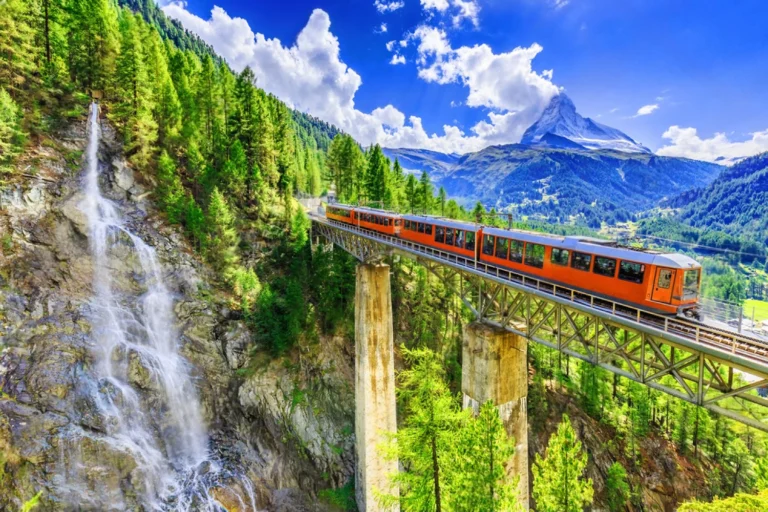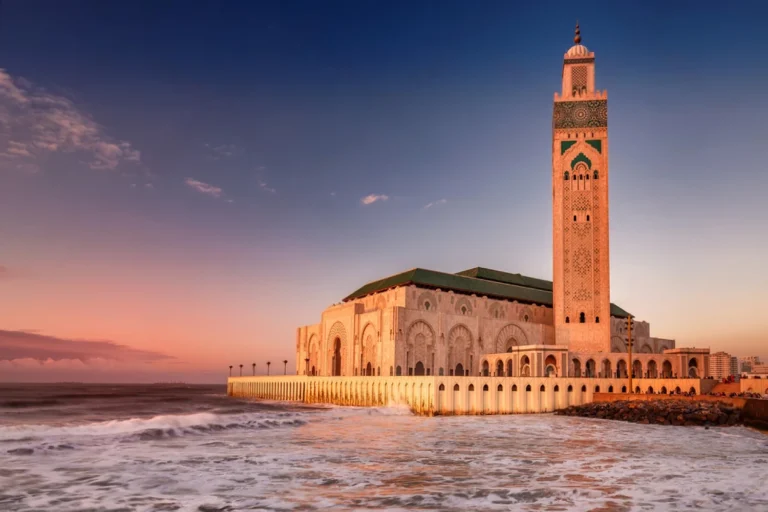Cristo Redentor: 30 Surprising Facts Above the Clouds of Rio
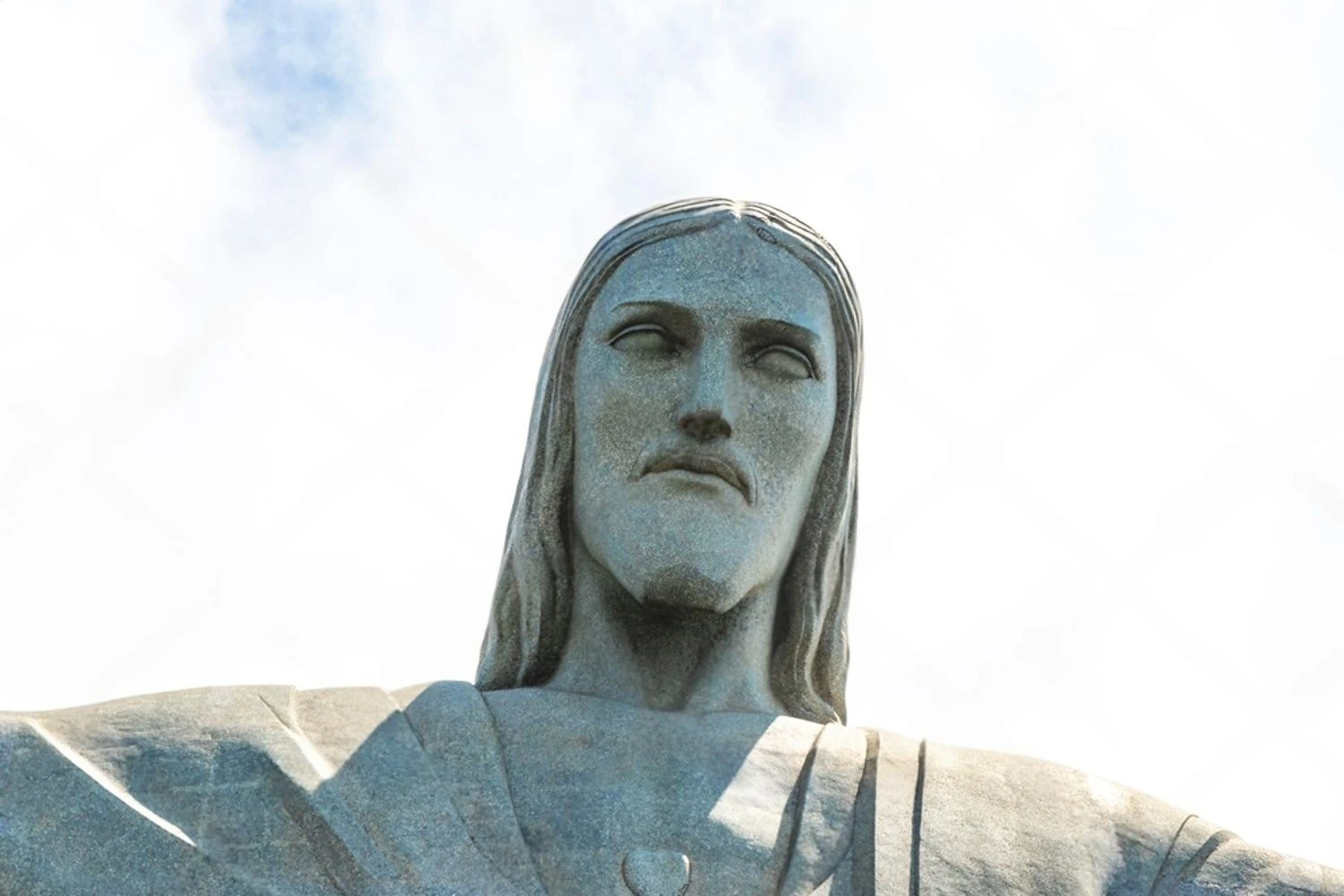
Some places reveal themselves slowly, like opening a well worn book whose pages smell faintly of salt and sun, and that’s how it felt to meet Cristo redentor. Tucked between the hush of clouds and the low hum of the city, a soft breeze brushed my cheeks while the stone under my palm held an unexpected cool. In a passing smile and the gentle rhythm of footsteps, it began to speak in undertones, hinting at stories that live just beyond the glossy picture. This is an invitation to linger, to trace the overlooked edges, and find the deeper spirit that waits where most glances don’t.
Before stone, a priest’s patient dream endured.
The first time those open arms floated out of morning mist, I remember thinking how unlikely it all felt. This wasn’t born from a grand decree or polished plan. Back in 1849, Father Pedro Maria Boss simply looked toward the mountain and imagined something holy there, then the idea slipped away for years, like a thread dropped and forgotten.
Decades later, in the 1920s, the church picked up that quiet thread and the city’s hands turned patience into stone. Faith, patience, and persistence paved that ridge long before any scaffold did; you can almost feel it in the wind, in the hush that lingers when the clouds move.
Rio de Janeiro has a way of teaching you that some things arrive on their own rhythm storms pass, drums return, and promises keep trying to be kept. Standing there, salt in the air and the granite cool under shade, I felt how gentle dreams can take the longest path, and somehow land exactly where they’re meant to like a promise finally kept, only sweeter for the wait.
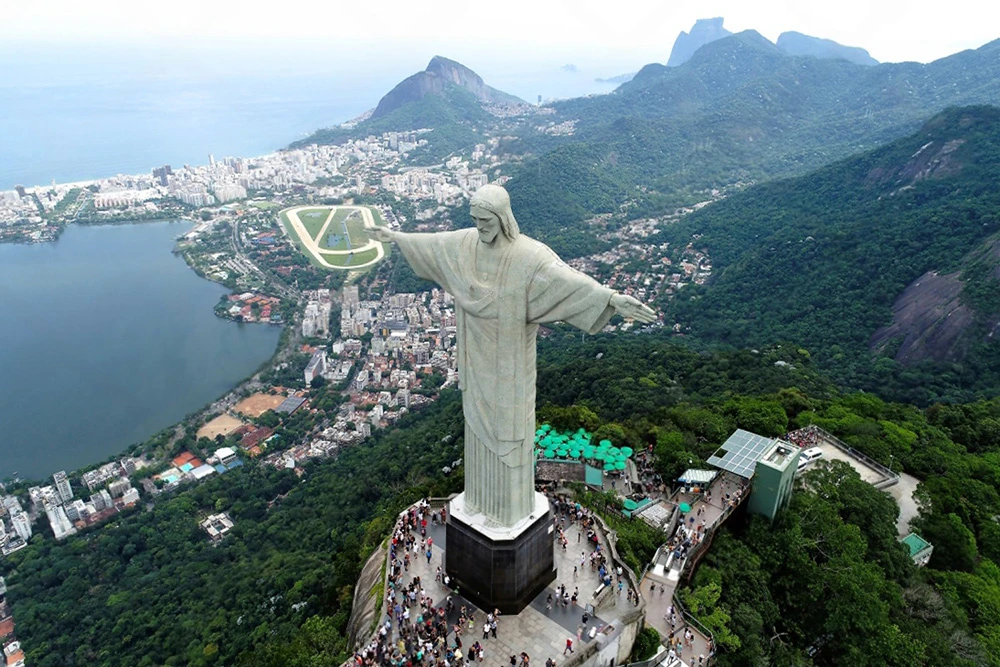
Rio’s embrace began far away, piece by piece.
It always makes me smile to think those famous arms met the Atlantic before they met the sky. The head and arms were shaped in a far off studio, chalk numbers brushed on their surfaces, settled into pine scented crates and sent across the ocean like a fragile puzzle waiting for its table.
There’s something tender about an icon assembled from distance and faith. Maybe that’s why, standing beneath it in Rio de Janeiro, the welcome feels wider as if the city learned its embrace abroad and brought it home.
I remember the wind up there, cool and salted, and the hush that makes conversations fall to a whisper. Knowing its pieces traveled so carefully makes the monument feel more human, built not just of stone but of patience, care, and all the hands that believed it would stand.
The Romanian touch behind Christ's gentle face
I still smile at the surprise of it: that calm, human gaze watching over Rio de Janeiro wasn’t shaped by a Brazilian or a Frenchman, but by a Romanian sculptor named Gheorghe Leonida. I remember looking up and thinking the face felt almost like a breath softer than stone should be before learning who carved that serenity.
Leonida gave the statue a tenderness that could have gone missing at that scale. The eyelids rest with a quiet patience, the mouth softened into kindness; from the ground, the expression hums like a quiet chord in a noisy song. Morning light warms the pale surface, sea breeze thins the haze, and the whole figure seems less like a monument and more like presence.
There’s something beautiful in knowing a stranger from far away shaped the city’s most familiar face. Travel keeps reminding me that places aren’t built alone; they’re stitched from faraway threads, and that’s why they feel so alive. Maybe that’s why his work lingers because gentle divinity is, at heart, a very human gift.
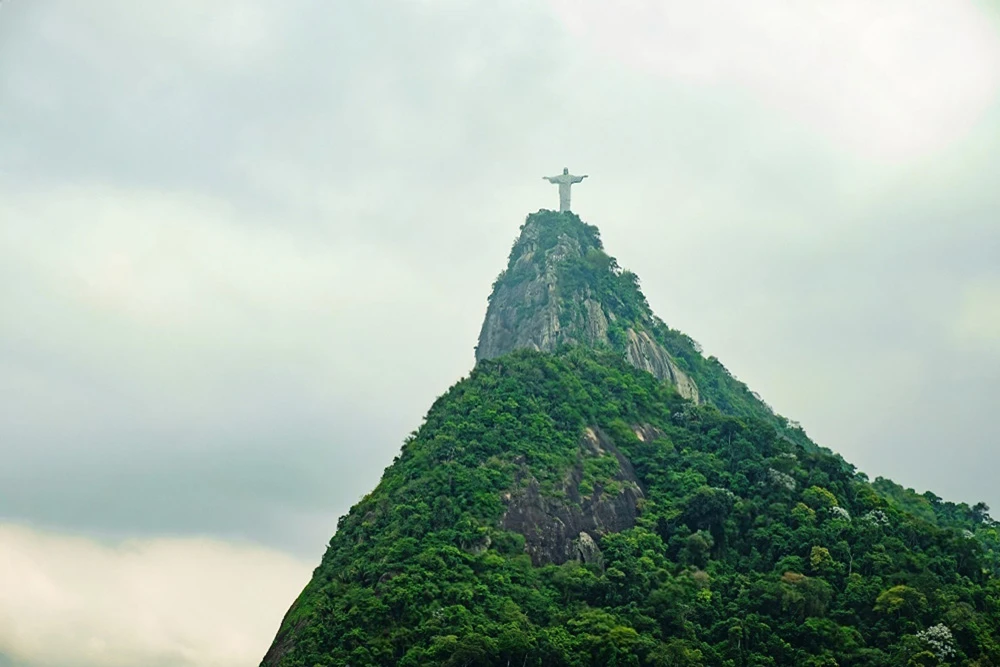
A saint in fifty pieces, rising through mist
I love that even legends arrive in pieces. The Redeemer’s 30-ton head came in fifty; his hands in eight. There’s something tender in that image greatness humbly boxed up like the city was being entrusted with a puzzle of faith and told, gently, to take its time.
People watched those parts float up the mountain through tropical mist, and it must have looked otherworldly, like the body of a giant saint assembling itself in the clouds. The air here can feel warm and damp, leaves shining with droplets, the world muffled and green, and Rio turns even logistics into a kind of hush before the reveal.
When I first heard this, it made me smile the way beauty sometimes arrives as fragments, then becomes whole only because many hands insist on it. That statue isn’t a single miracle; it’s patience made visible, stitched together like a long, quiet prayer. And maybe that’s the real spirit of the place: joy and faith built piece by piece, rising, until the mist parts and you finally see it.
Six million tiles, some holding whispered names.
It’s the quiet detail that steals your breath: the cool, pale mosaic you see from the ground was placed one triangle at a time, more than six million pieces, each pressed by human hands. I remember the sun sliding over that pebbled soapstone and thinking how care can be stitched into the sky.
What moves me most is the hidden tenderness of it. Many of those tiny tiles were signed by the women who worked them, beloved names inked on the back before they were sealed forever to stone and wind. It feels so true to Rio de Janeiro: a city that celebrates loudly, yet keeps tiny acts of love where no one can see, like quiet prayers carried by the statue’s open arms. You don’t need to read the names to feel them; standing beneath, the place feels gentler, grounded by all that careful work.

A monument built from a nation’s small gifts
What moves me most is knowing that statue rose from ordinary pockets, coin by coin. It wasn’t a trophy for the powerful; it was the kind of promise families make in kitchens and parish halls. All those small amounts, stitched together like a quilt of faith, became a national act of love.
I picture the clink of coins in wooden boxes, the waxy drift of candle smoke, envelopes passed hand to hand with names and hopes tucked inside. Every cent arrived carrying something extra pride, a whispered prayer, or both. Somehow it all felt personal, like a country choosing to believe together.
And when you finally look up at the open arms above Rio de Janeiro, you can almost hear that generosity move through the wind. It doesn't feel like an elite monument at all; it feels like being welcomed into a story everyone helped write. I remember standing there quietly, grateful for the countless small gifts that made something big enough for all of us.
When Brazil made Art Deco holy and it worked
Funny how a style made for jazz age lobbies and slick skyscraper spines can feel sacred. Up there, the clean lines aren’t flirting with speakeasies; they’re catching sunlight on pale stone, the air thin and bright, birds tucking little commas into the sky. Those open arms turn geometry into comfort like a lighthouse for the heart.
In Rio de Janeiro, it suddenly made sense to me: Brazil has a way of making the glamorous feel generous. Art Deco here doesn’t pose; it welcomes, giving modern angles a soft pulse, as if the city’s own samba beat had settled into the statue. I remember smiling at the audacity of it, how the biggest Art Deco monument in the world could also be the gentlest, proof that style can hold a quiet kind of faith.
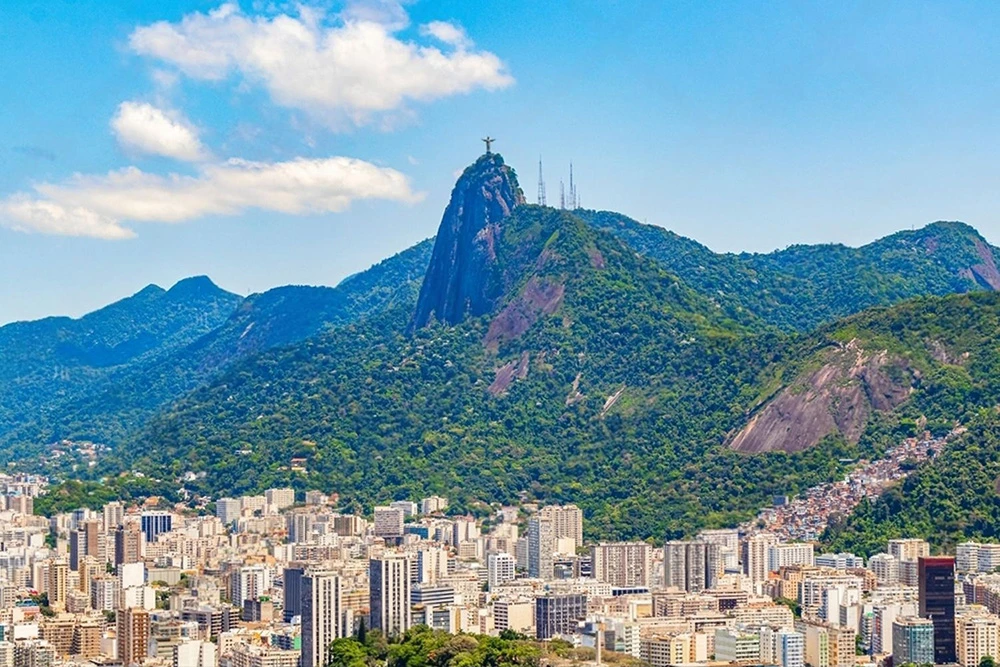
Open arms built for storms and centuries
I remember the wind up there tasting of salt and cloud, a low hum in my ears with his open arms and the skyline wide in front of him. Someone said he stands on Corcovado, 710 meters above the sea, and can stare down winds of 250 km/h stronger than a Category 5 hurricane without a flinch. Hearing that, the whole mountaintop felt steadier, like the air itself had learned to be brave.
Heitor da Silva Costa designed him not just for tempests but for time, a kind of open armed lighthouse watching over Rio de Janeiro. I love that idea: in a city that lives between mountain and tide, music and thunder, there’s a figure calibrated for chaos and gentle with patience. It made me think about our own weathered days, and how sometimes the most courageous act is simply to keep standing while the years stitch themselves quietly around you.
October 12, a shared day of devotion
I love that October 12th in Brazil carries a quiet surprise. Christ the Redeemer was inaugurated on that very day in 1931, the national day of Our Lady of Aparecida, the country’s patron saint. A modern monument sharing a date with an older devotion every year the country honors both, one crowned, the other crowned with clouds.
In Rio de Janeiro, morning light softens the stone while church bells travel the streets, and the air smells of salt and spring rain. Blue banners sway from windows, candles flicker in doorways, and songs rise and fall, steady and tender.
I remember feeling oddly comforted by that pairing, as if the city could hold two heartbeats in one day. It says something about the spirit here: reverence that still makes room for joy, a faith that welcomes the sky and whatever weather it brings.
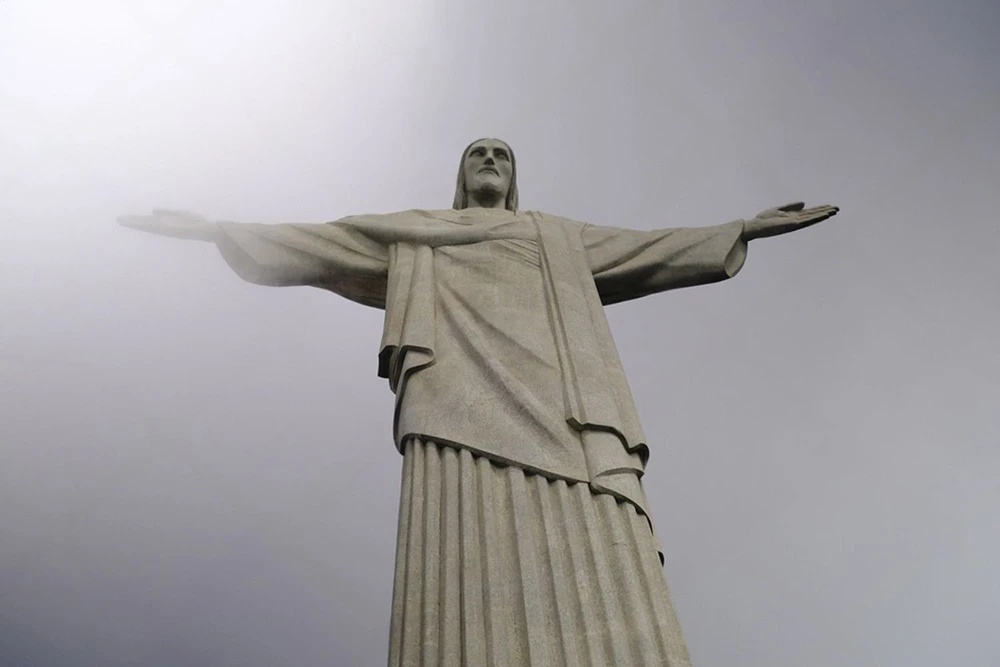
Vows beneath Christ’s feet, in a hidden chapel
I didn’t expect the quiet up there. Under the famous statue is a tiny chapel to Our Lady of Aparecida, candlelight breathing against cool stone, voices dropping to a hush as if the place were a pocket of sky folded into rock. The air smells faintly of wax and rain, and the echo is gentle, like being held in a cupped hand.
Some couples marry right there, directly under Christ’s feet, and it’s somehow both the most dramatic and the most intimate place to say yes. Outside, Rio de Janeiro is all bright ocean and restless hills; inside, the vows sound steadier, protected by the mountain and those patient shoulders above. I remember thinking how love can bloom anywhere, but here it feels brave, not showy – a quiet promise made at the heart of a spectacle.
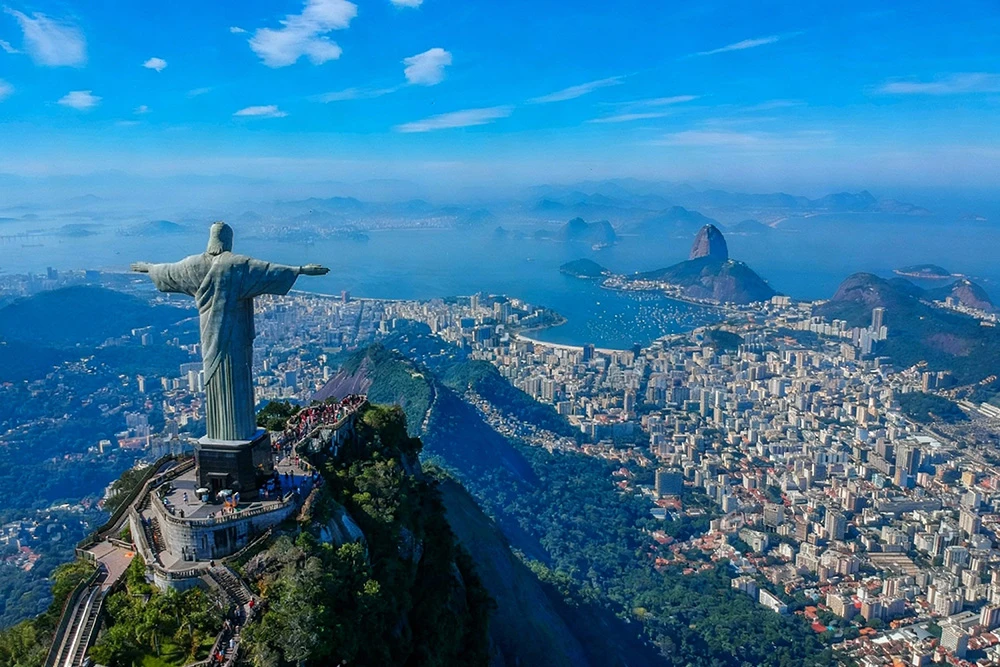
The Redeemer’s sandals would be size 530
I laughed when I first heard it: if Christ the Redeemer ever wore sandals, they’d be a size 530. Imagine the poor shoemaker, tape measure flapping in the mountain wind, squinting up at those stone toes while the sun warms the granite and the air smells faintly of salt. That number is so wildly human and absurd, it makes this serene giant feel surprisingly close, like a joke whispered from the clouds.
The scale of it says something about the place, too how hopes here seem to come in wide, sweeping sizes. High above Rio de Janeiro, those open arms stand like a lighthouse of welcome, and the idea of shoes that immense makes me smile; it hints that kindness is meant to go the distance. I carried away the odd comfort that even our tiniest worries would look small beside feet that size.

When lightning tests the mountaintop guardian’s patience
I remember an afternoon storm rolling in, the air tasting like metal and the sky crackling like a live wire. Up on the mountain, the statue kept taking the hits lightning finds him again and again and every so often he pays for it, losing a fingertip or even an eyebrow. In 2014 a bolt snapped part of his right thumb, a small wound you could almost miss from far below but hard to forget once you know.
What I love is how the repairs bring him back with the same pale soapstone the Brazilian mountains have been shedding since the 1920s. There’s something tender in that rhythm storm, scar, mending that feels very Rio de Janeiro: weathered and luminous, a city stitched back together with its own earth, ready for whatever rolls in next.
The pale stone that keeps its cool
Midday light can be ruthless, the kind that presses on your shoulders and turns handrails into little suns. And yet the soapstone cladding up there stays cool – a pale skin from Sweden that feels like shade poured into stone. I remember thinking how strange and tender that is: a northern rock keeping its calm while everything around it shimmers.
It wasn’t chosen just to look pretty. The color was a deliberate bit of foresight, reflecting heat so the surface wouldn’t scorch in Rio’s tropical glare. That practicality hides in plain sight, a quiet kindness built into the design; beauty doing a second job. I love when a place teaches that – that grace can be sturdy, that comfort can be planned – and you can feel it with your own skin, a whisper of winter under the fiercest sun.
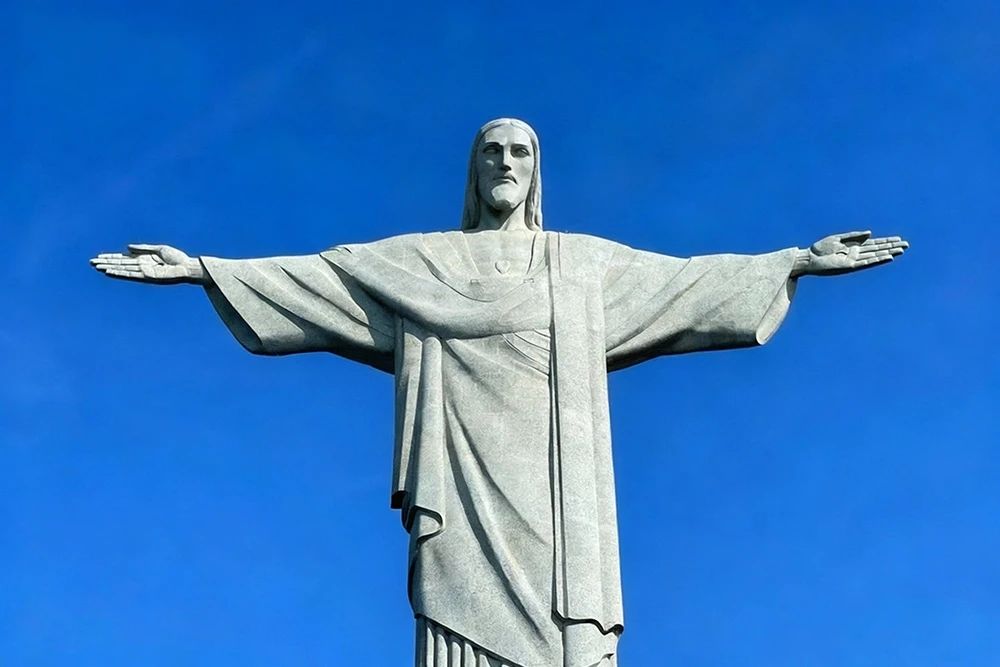
Two hundred steps once, now a gentle glide
I still think about how this view once asked for effort. Two hundred steep steps imagine the huff of it, the sting in your thighs, the way your heartbeat quickens. The first time I rode the glass elevator, a cool draft grazed my face and the forest smelled like wet leaves and warm stone; I tried to picture all those souls before me, climbing into the sky one breath at a time.
In Rio de Janeiro, the panoramic elevators and escalators, added in the early 2000s, let you float upward now, watching rooftops, the bay, and green hills ease into view. The escalator hums, a silver ribbon unwinding, and you arrive with breath left over for awe like being lifted by a quiet tide so knees and hearts alike can share the same wonder. Part of me admires the grit of the old way, but there’s a kind of kindness in this gentler ascent, a reminder that access can be its own form of grace.

A city held in an outstretched embrace
Some afternoons, a long shadow glides over the green ribs of the hills, skims the patchwork of rooftops, and slips out toward the glittering sea. It’s gentle, never hurried, like a slow sundial marking the day with grace. Christ’s arms, 28 meters wide, cast it quiet, steady across forest trails, bright painted favelas, and the wide, salted air.
Locals grin and say the embrace reaches everyone, from Copacabana’s warm sands to the drums and laughter in Lapa. I remember believing it the first time a breeze off the Atlantic tasted faintly of salt and sugar cane, and the city felt small enough to hold. In Rio de Janeiro, you don’t just look up at Christ; you notice how his shadow makes neighbors out of neighborhoods.
Maybe that’s the surprise the stone feels softer from a distance. As the light wanders, the city seems gathered, as if someone pulled a shawl over weary shoulders just before evening. It’s less about being watched than being welcomed.

Hidden blessing revealed by a bird’s eye glance
Funny how the sky keeps the best secrets. From above, the statue’s base unfolds into a giant cross clean and unmistakable as if the city had been anointed long before drones could climb high enough to prove what faith already suspected. The idea lingers; ordinary corners suddenly feel a shade gentler.
In Lisbon, I remember the wind smelling faintly of salt and warm stone, the murmur of traffic rising like a soft tide. At eye level you’d never guess the geometry beneath your feet; it just feels like a quiet terrace where strangers drift close enough to share the same breeze for a minute.
Maybe that’s the point: someone designed a blessing not for cameras, but for the heavens. A quiet benediction stitched into the city, reminding you that some places were loved long before we learned new ways to look.
A Brazilian icon with a quiet Parisian heartbeat
I always thought that great embrace belonged wholly to Rio sunlight brushing soapstone while the bay breathes below. Then I learned the irony: inside that outstretched figure above Rio de Janeiro, the metal ribs were forged in France. The idea landed softly, like sea mist on skin, and suddenly the statue felt both local and far traveled at once.
Some of the original molds still rest in old Parisian workshops, dust settling on their edges, the air a mix of machine oil and wood shavings. I like picturing them there patient remnants of a dream while the finished giant keeps watch across an ocean. It’s as if the statue carries a passport, stamped by two cities that never needed a border to understand each other.
And somehow that makes it more beautiful: a reminder that even the most “Brazilian” masterpieces are stitched with distant hands. Maybe that’s the quiet secret of places we love they borrow pieces of the world and, in the borrowing, become more themselves.
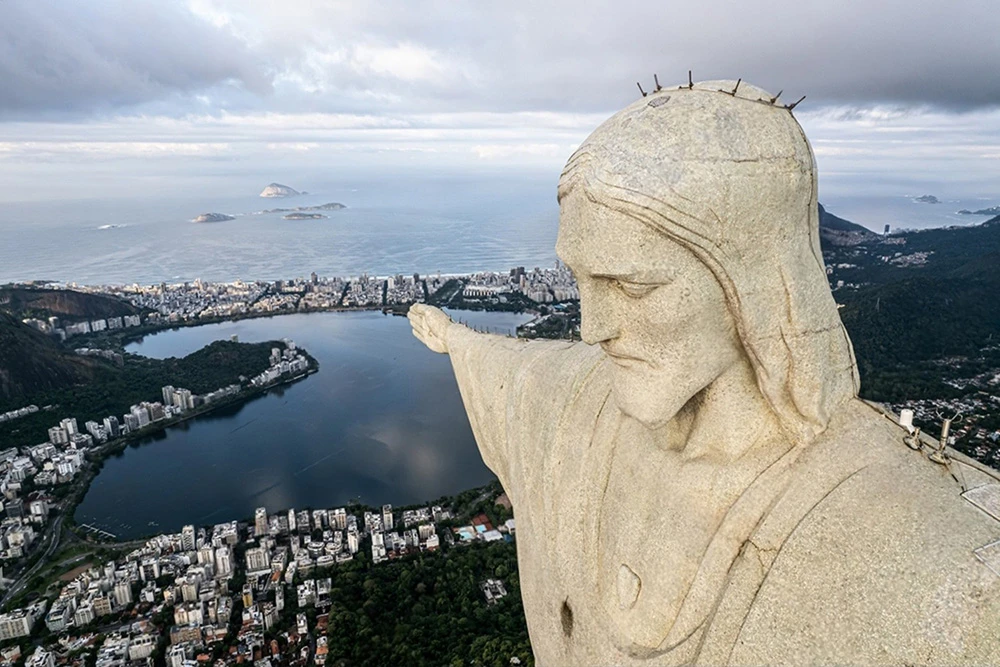
Built on ropes and prayers, no lives lost
I can’t shake the image: sun glaring off pale stone, grit catching at the back of the throat, the wind combing the mountain while men balanced on rope ladders and creaking planks. In the 1930s, the closest thing to a safety harness was faith murmured under the breath. You can almost hear the tap of hammers, the rasp of hemp against palms, that stubborn courage that feels both ordinary and enormous at the same time.
Nine years, and not a single death recorded. It feels like a quiet benediction laid over the city, the kind of grace you don’t brag about because you’re still a little stunned it happened. I remember learning that and thinking how much care must have been poured, hour by careful hour, into each seam of stone above Rio de Janeiro. Maybe that’s the spirit of the place work done with simple tools, shared trust, and a hope big enough to hold a mountain.

A solid heart beneath a gentle skin
I always assumed statues were hollow, echoing inside like empty shells. Then I learned this one isn’t: it’s solid to the core with reinforced concrete, wrapped in small, cool tiles of soapstone. Up close the surface looks like a quiet gray mosaic that keeps its calm even under a stubborn sun; the breeze tastes faintly of salt, and the stone seems to hold that freshness the way skin holds morning air.
That unusual pairing strength within, soapstone without has given it a steadiness that shrugs off time and tremors. In Rio de Janeiro, where storms can roll in fast and life moves with a quick, bright rhythm, there’s comfort in knowing the figure above isn’t delicate at all, just gracious. I remember realizing that and feeling oddly reassured, as if the place were whispering that gentleness isn’t fragility, and that some of the firmest things wear their strength quietly.
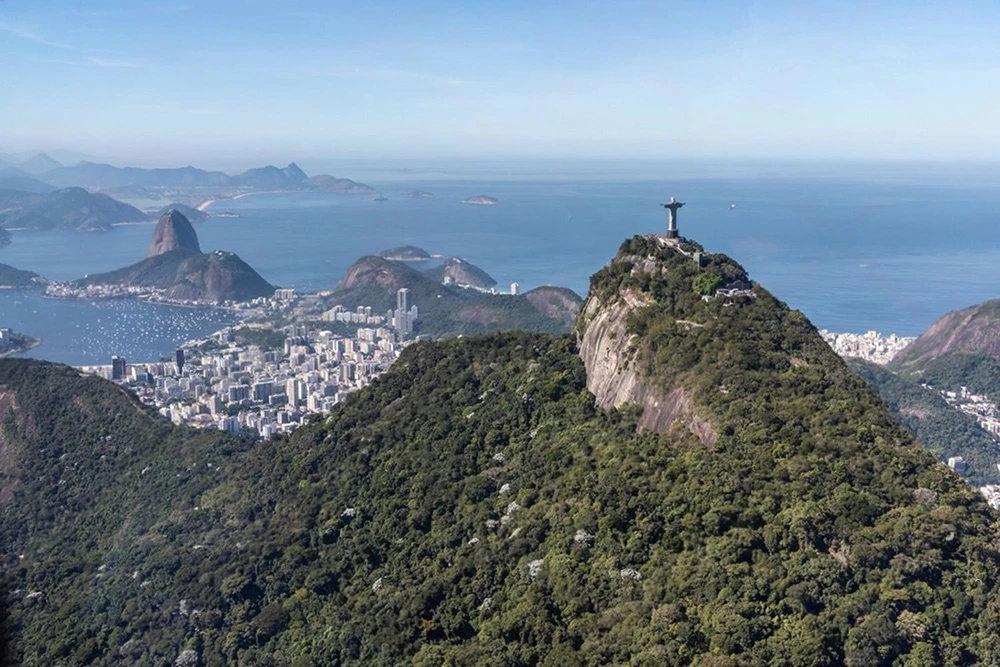
Once a decade, caretakers rappel and hand tint weathered tiles.
I didn’t expect a stone colossus to need such tender care. Then you learn that every ten years, tiny specks appear against the pale surface people on ropes, swaying in the mountain wind, coaxing out mildew, stitching up hairline cracks, and replacing fallen tiles with new ones they color by hand to match the sun faded, rain washed tone of an eighty year old face. It’s so delicate, almost domestic like darning an heirloom sweater this quiet work on a giant.
In Rio de Janeiro, where salt air and sudden showers soften everything, it feels right that even a monument survives on patience and human hands. There’s something moving about trying to match the hue of time itself; it makes the statue feel less distant, more like a neighbor the city checks on someone they gently scrub and steady before another decade of storms and light. I remember walking away with a small, grateful calm: the strongest things endure because people keep loving them back, giving a giant a quiet bath before the weather comes again.
https://en.wikipedia.org/wiki/Christ_the_Redeemer
No photo prepares you for this green immensity
You think you know it from the postcards, and then the scale hits this rainforest doesn’t just sit below, it heaves and breathes in every direction, a living sea under Christ’s calm gaze. The air is warm and leafy, the kind that softens your edges; sunlight sifts through the canopy and makes the world feel both grand and gentle at once. I remember feeling very small, but in a good way, like someone had turned the volume down on worry.
They call it Tijuca National Park, one of the world’s few true urban jungles, though “urban” sounds too tidy for a place where monkeys chatter in the green and hummingbirds hum past your ear like tiny engines. Every so often the leaves part and you catch a sliver of rooftops and blue water and remember you’re still in Rio de Janeiro. That’s the beautiful trick here: wildness and city sharing a heartbeat, teaching you that vastness can be tender, and that even in the busiest places, nature still holds the reins.

The Day They Tidied Up for the Boss's Boss
I love how a city blushes before an important visit. In 1980, when Pope John Paul II arrived in Brazil, Christ the Redeemer above the bay finally got a ceremonial cleaning – the first of its life. Friends in Rio de Janeiro still tell it with a grin: the whole country tidied up for “the boss's boss.” That line always makes me laugh and nod at the same time.
I wasn’t there, but I can almost hear the quiet scrape of bristles on soap slick stone and feel the salt breeze fussing at everyone’s hair. There’s something tender in the idea: people carefully washing the city’s great symbol, like straightening the sheets before a beloved guest arrives. It’s reverence with a playful wink, the kind that keeps belief human.
Maybe that’s why the story lingers with me. It says the sacred doesn’t have to be distant or severe – it can be cared for, even joked with, and somehow shine brighter for it. Every time I remember it, I think of how pride and affection can polish a place just as surely as water and cloth.
Five elephants’ weight, balanced between sky and sea
I still can’t wrap my head around this: that serene face above us hides a head weighing about thirty metric tons roughly five elephants. The wind up there smells like salt and green leaves, and the stone looks almost soft in that light, as if it could exhale.
They inched it up the mountain with cranes and pulleys and timing that felt almost miraculous, as if threading a needle between sky and sea. In Rio de Janeiro, the stakes were absolute: one misstep and that calm gaze might have been lost to the Atlantic, the city’s gasp swallowed by waves.
What moves me most is how that quiet poise was earned born from stubborn hands, shared breath, and a shared belief that something heavy could be lifted into grace. I remember a sunset when the city below was cupped like a bowl of light, and I felt this hush of gratitude for the people who risked so much so a stranger could look up and feel lighter.

Storms conducted, not unleashed, by hidden rods
I love how, when the sky darkens and the air tastes metallic, the statue doesn’t flinch. Rain warms the stone, wind lifts the gulls, and those discreet lightning rods do their quiet work like a conductor’s baton, they give each wild bolt its cue and lead it straight into the earth. And just like that, the skyline of Rio de Janeiro keeps breathing, not burning.
There’s something tender in that arrangement, a small mercy built into metal and faith. I remember watching a storm roll in, the crack and flare arriving with a jolt, and then that soft hush after the strike, like someone turning down the volume. It made me think how some places teach even the weather to behave with a kind of grace fierce, yes, but guided, so the city can sleep through the thunder.
Cristo’s colors shift with light and humid air
I used to think stone stayed one color, steady and sure, and then sunrise proved me wrong. When the air felt soft and salty, his surface warmed to a pale gold, like the morning had leaned in and lit a candle under his robe. The mist clung to my skin and to his too; he wears the weather like a second skin, and suddenly the cold icon felt tender, almost awake.
By evening he settles into a soft bronze, as if the day left a slow glow behind, and on dry afternoons he turns back to a calm gray. It surprised me how a statue could change with the sky, the way people do with their own moods. In Rio de Janeiro, that felt right nothing here holds just one feeling for long, and even Cristo shifts with the light, reminding me that constancy can live inside change. I remember thinking, if a giant of stone can be many colors, maybe I’m allowed to be, too.
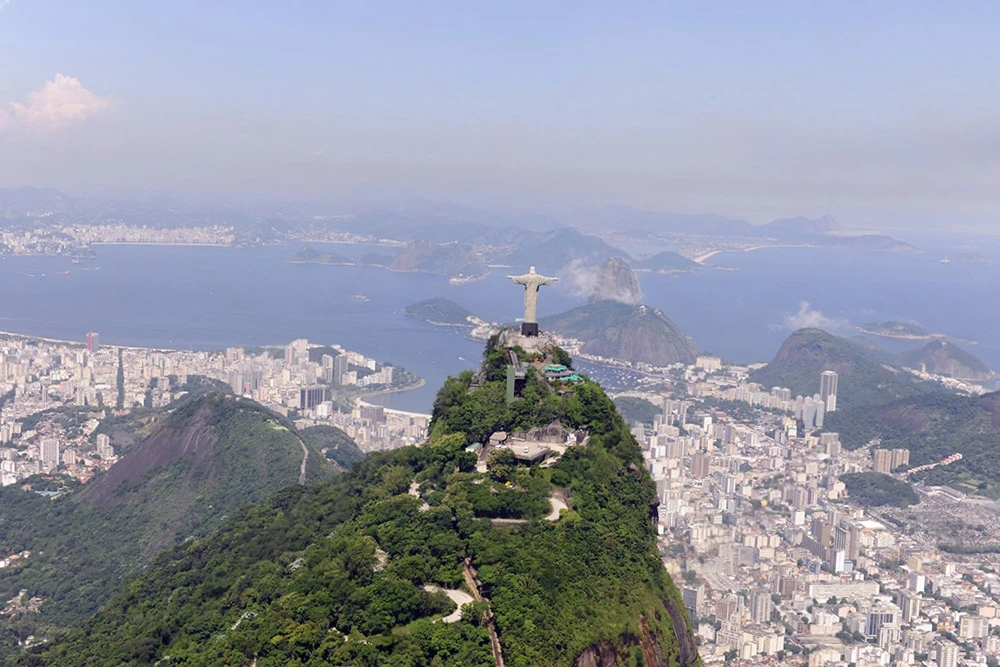
A statue whose shadow reaches all the way to space
I still smile at the thought that a shadow can be seen from space. Astronauts once caught Christ the Redeemer’s silhouette printed on Corcovado’s slope, crisp and long in the slanting sun, like a celestial stamp. It makes the distance between ground and sky feel smaller, almost neighborly.
In Rio de Janeiro, that statue has a quiet way of steadying you, like a neighbor watching over the city. I remember the salty breeze up there, the afternoon light turning the bay almost silver, and realizing how grand things can still feel gentle. A shadow reaching orbit sounds impossible, yet it suits this place where joy travels fast where music, warmth, and small gestures somehow carry farther than you expect.
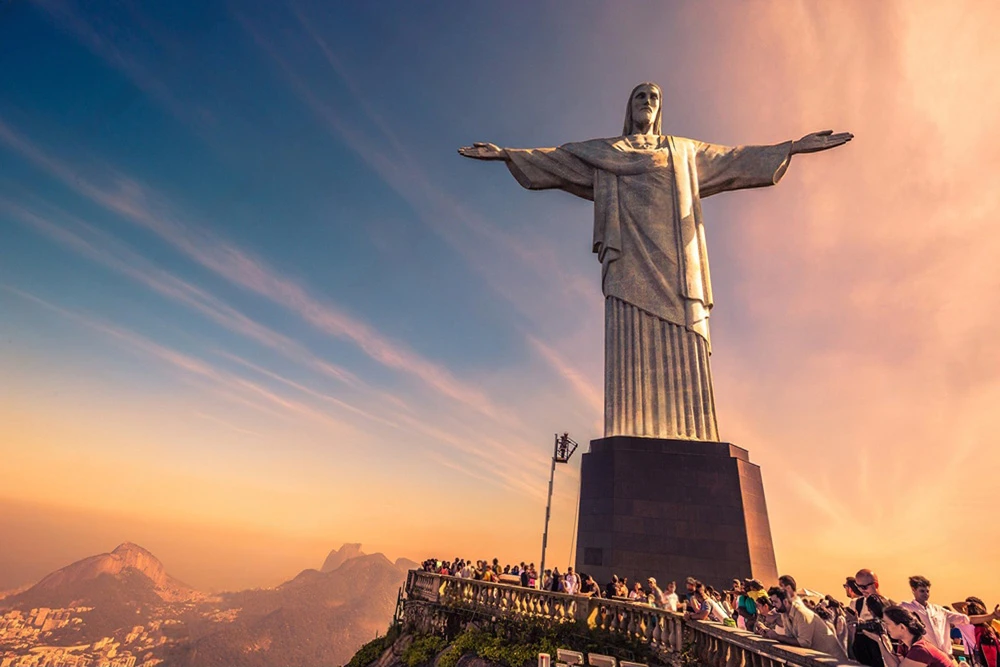
The secret window in the chest
I love that there’s a tiny door hidden in there. Somewhere behind the quiet framework, technicians climb narrow ladders to a small hatch, where the air is cool and smells faintly of oil and dust. I picture the inside humming softly, light slipping through little portholes that blink at the sky, and the wind whispering through seams you’d never notice from the plaza below.
A guide once told me the rumor everyone swears by: the view from those interior portholes is more moving than any grand lookout. Maybe it’s the way the world is held still in a small oval, intimate as peeking into a locket, so the city feels closer and kinder. From up on the mountain above Rio de Janeiro, the sea and hills would meet your eye without fanfare, clouds brushing by like neighbors rather than decorations on a postcard, as if you were borrowing the statue’s gaze for a quiet minute.
I think about that when places feel too big to take in all at once. The hush behind the chest, the modest window, the pared down view maybe that’s the secret: the heart of a city shows itself best in small frames, where the sweep turns into a feeling and the distance suddenly fits in your hands.
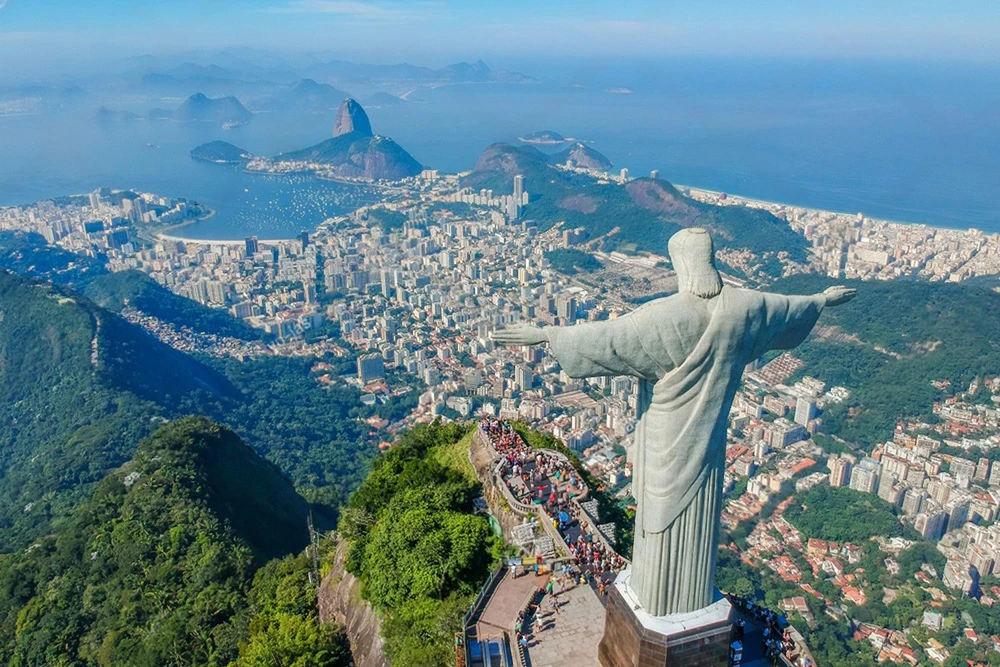
A minute of darkness for a brighter peace
There’s a hush that sneaks in after dusk, the kind that makes you look up. For a single minute, the floodlights around Christ the Redeemer soften and the hill slips into gentle shadow. The air tastes of salt and jacaranda, buses hum faintly, and down below in Rio de Janeiro the windows glitter like constellations. It feels like the city holding its breath.
I remember the first time I noticed it thinking how rare it is for a famous monument to choose silence. They’ve done it since 2007, the year the statue was named among the New Seven Wonders, a small ritual for world peace that asks nothing but a pause. In that pause, strangers seem a little closer, the night a little kinder, and the hope that travels between us somehow easier to believe.
Where faith and football celebrate side by side
It still gives me goosebumps after a big win, a hum rolls up the hill. Drums flicker through the crowd, car horns answer, and the smell of fireworks hangs sweet and metallic. Families in green and gold sing in ragged harmony, some wiping tears, others laughing, all of them lifting gratitude toward the outstretched statue that keeps watch like a lighthouse over a tide of yellow jerseys.
I learned there that joy can be a prayer. In Rio de Janeiro, faith and football aren’t rivals; they’re two rhythms braided into one heartbeat, and the whole city seems to move to it. People don’t ask for miracles on those nights they say thank you for the ones already here: neighbors hugging strangers, voices warming the dark, that quiet relief of believing together. As the songs carry through the breeze, you feel it victory settling into gratitude, celebration turning softly sacred.
He faces east, greeting the first light.
I still love how no one really talks about it: all that grandeur, and yet he’s turned simply toward dawn. Millions look up each year and forget that his gaze is steady, patient, and hopeful, like a stone lighthouse for a tide of light. There’s something tender in that ritual every morning he keeps the quiet appointment, waiting for the world to brighten one soft minute at a time.
At first light, the air feels clean and a little salty, birds sketching quick loops over the dark water while the hills blush pink. I remember thinking how humble it is, this daily beginning no trumpets, just warmth seeping into the city as it stretches awake like a cat. And that’s the secret I carry about Rio: even the biggest symbol doesn’t try to outshine the sunrise. It just faces it, again and again, reminding you that wonder often starts by turning toward whatever is just about to arrive.
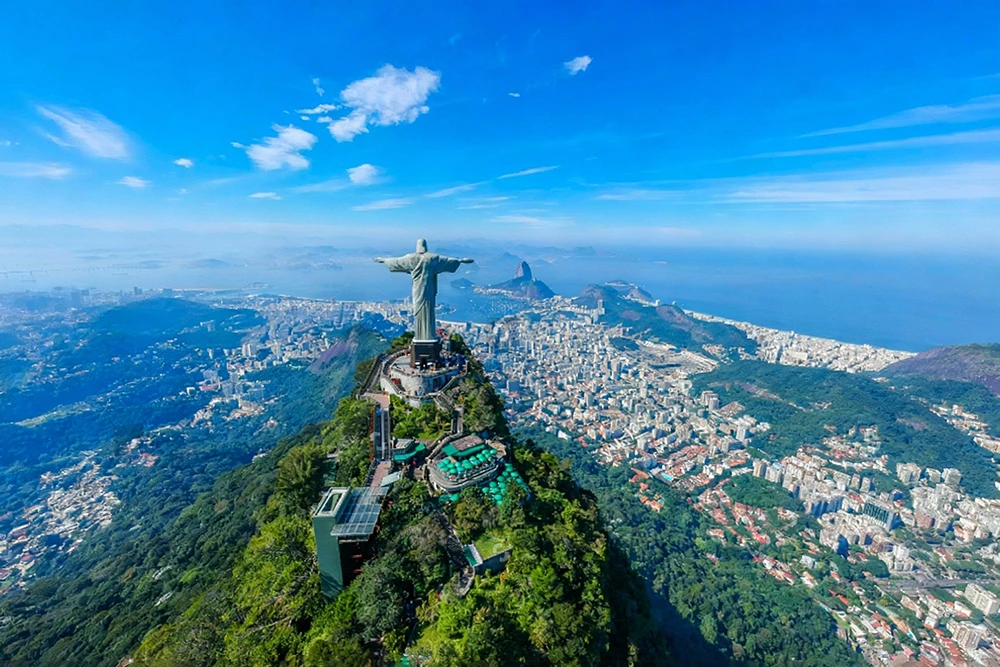
Final thought
Amid hidden stories, small details, and passing human moments, the truer side of Cristo Redentor feels quietly near. I notice patient care in the way steps slow and strangers make room for one another. Together these bits belong to something larger, like a single soft thread that holds a sleeve in place. I leave simply looking up, ready for more wonder.




